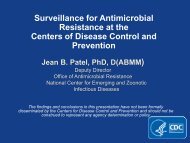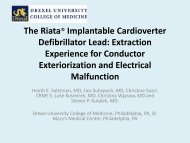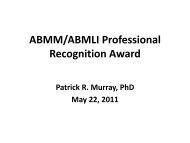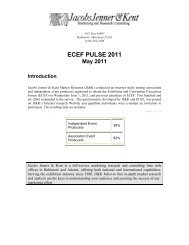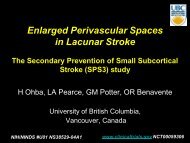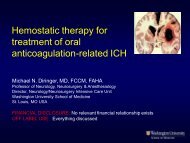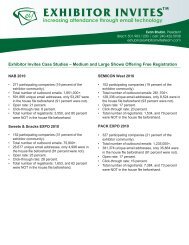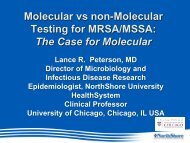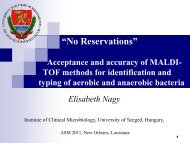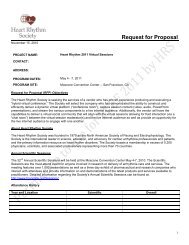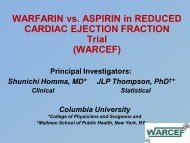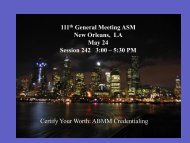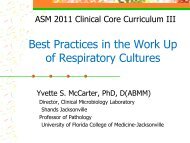S. aureus
S. aureus
S. aureus
You also want an ePaper? Increase the reach of your titles
YUMPU automatically turns print PDFs into web optimized ePapers that Google loves.
The Skin Microbiome -<br />
Clinical Laboratory Impact on<br />
Hospital Acquired Infections Affecting<br />
Patient Outcomes<br />
ASM, New Orleans<br />
May 22, 2011<br />
Lance R. Peterson, MD<br />
Director of Microbiology and<br />
Infectious Disease Research<br />
Epidemiologist, NorthShore University HealthSystem<br />
Clinical Professor<br />
University of Chicago, Chicago, IL USA
• Research Grants<br />
Potential COI<br />
– Bayer, Cepheid, NorthShore, GeneOhm, GSK, Johnson and<br />
Johnson, Merck, MicroPhage, Nanogen, Nanosphere,<br />
NIAID, Roche, 3M, Washington Square Health Foundation,<br />
Wyeth (Pfizer), AHRQ<br />
• Consultations (in conjunction with research projects<br />
and new diagnostics)<br />
– Cepheid, GeneOhm, GSK, MicroPhage, Nanogen,<br />
Nanosphere, Roche, 3M, Wyeth (Pfizer)<br />
• Industry support for this presentation<br />
– None
Objectives<br />
• Review the relevance of the skin Microbiome to<br />
infections impacted by the clinical laboratory<br />
• Discuss the application of MRSA surveillance<br />
• Summarize the literature on pre-surgical testing<br />
for S. <strong>aureus</strong> to lower surgical site infection
Skin Ecology<br />
• Hairy, moist underarms lie a short distance<br />
from smooth dry forearms<br />
– “These two niches are as ecologically dissimilar as<br />
rainforests are to deserts”<br />
• Molecular approaches (as opposed to<br />
traditional culture) have revealed a greater<br />
diversity of skin microbiota within and<br />
between distinct topographical regions<br />
• Methicillin-resistant S. <strong>aureus</strong> acquired genes<br />
that promote growth on skin from the symbiont<br />
S. epidermidis<br />
EA Grice et al. Science 324:1190-2, 2009<br />
EA Grice et al. Nature Rev Microbiol: 9:244-253, 2011
Skin Ecology - Dominance<br />
• Propionibacteria and Staphylococcus species<br />
predominate in sebaceous sites<br />
• Corynebacteria spp. predominate in moist<br />
sites, although staphylococci also are present<br />
• A mixed population of bacteria reside in dry<br />
sites, with a greater prevalence of<br />
β-Proteobacteria and Flavobacteriales<br />
• Unique microenvironment of the anterior<br />
nares consists of moist, epithelia contiguous<br />
with noncornified nasal mucosa and drier<br />
keratinized skin EA Grice et al. Science 324:1190-2, 2009<br />
EA Grice et al. Nature Rev Microbiol: 9:244-253, 2011
Microbiome of the Nose<br />
• Studied 5 healthy carriers and 42 hospital patients<br />
– Culture-independent analysis of 16S rRNA<br />
• Healthy nares had only two bacterial phyla<br />
– Actinobacteria (i.e., High-G+C Gram positive organisms<br />
such as corynebacteria - 68% of sequences)<br />
– Firmicutes (i.e., Low-G+C Gram positive organisms such<br />
as staphylococci - 27% of sequences)<br />
– S. <strong>aureus</strong> found in the nares (of 2/5 individuals)<br />
– Nares samples similar mostly to each other (p
Microbiome of the Nose<br />
• S. <strong>aureus</strong> was most abundant in patients classified<br />
as S. <strong>aureus</strong>-carriers by femA PCR<br />
– Confirms the diagnostic utility of the femA PCR assay<br />
used to classify patients with staphylococcal species<br />
DN Frank et al. PLoS ONE 5(5):<br />
e10598. doi:10.1371, 2010
What Does this Suggest for the<br />
Clinical Laboratory?
Risk for S. <strong>aureus</strong> Infection<br />
• Systematic review (10 studies) to estimate of<br />
the risk of infection following colonization with<br />
MRSA compared with colonization by MSSA<br />
• Random effects model was used to obtain<br />
pooled odds ratio estimates<br />
• Overall, colonization by MRSA was<br />
associated with a 4-fold increase in the risk of<br />
infection (odds ratio 4.08, 95% confidence<br />
interval, 2.10-7.44) N Safdar et al. Am J Med 121:310-15, 2008
Risk for S. <strong>aureus</strong> Infection<br />
• Measured 1-year risk of MRSA infection<br />
following detection of nasal colonization<br />
– 4 hospitals over 4.5 years with 211,339 episodes<br />
• 1-year risk of MRSA infection was 11.8% for<br />
nasally colonized persons<br />
• 1-year risk of MRSA infection was 0.7% for<br />
non-colonized persons<br />
D Ridgway et al. IDSA meeting, 2011<br />
• Suggests 1-year risk of MSSA infection is<br />
2.9% for nasally colonized persons
Review of Mupirocin<br />
Decolonization<br />
• Nasal carriage of S. <strong>aureus</strong> is a defined risk<br />
factor for subsequent infection in patients<br />
• 8 studies compared mupirocin with placebo<br />
or with no treatment: Statistically significant<br />
reduction in the rate of S. <strong>aureus</strong> infection<br />
associated with intranasal mupirocin (RR<br />
0.55, 95% CI = 0.43 to 0.70)<br />
M van Rijen et al. Cochrane Database of Systematic Reviews 2008,<br />
Issue 4. Art.No.:CD006216.
Critical Review of MRSA<br />
Screening by Rapid Methods<br />
• Review and meta-analysis of randomized, nonrandomized,<br />
and observational studies<br />
– Random-effect model was used<br />
– Ten studies (nine interventional studies and one<br />
unblinded, cluster-randomized, crossover trial) reviewed<br />
• Between wards applying rapid screening tests and<br />
those without screening, noted a significantly<br />
decreased risk for MRSA bloodstream infections<br />
• Overall, concluded that active screening for MRSA<br />
is more important than the type of test used<br />
E Tacconelli et al. Lancet Infect Dis 9: 546–54, 2009
CDC Surveillance (2005)<br />
• Prospective study on MRSA risk<br />
• Nearly 9,000 cases from 9 sites (ABC surveillance)<br />
– 77% of HAI* were blood infections (2-fold rise in 6 years)<br />
– 31.8 invasive infections/100,000 persons<br />
– Nationally translates to 94,360 cases of invasive disease<br />
– 18,650 annual US deaths (greater than HIV-AIDS)<br />
• No longer well defined risk groups<br />
• 85% healthcare associated<br />
– “It is a major health problem primarily related to health care<br />
but no longer confined to intensive care units . . ”<br />
* HAI = Healthcare Associated Infection<br />
- RM Klevens, JAMA 298:1763-71, 2007
Comparative Mortality of MSSA<br />
and MRSA Bacteremia<br />
• Meta-analysis of 31 reports from 1980-2000<br />
– 3963 MSSA and 2603 MRSA cases<br />
– Significant increase in mortality noted for MRSA<br />
» OR 1.93; 95%<br />
CI = 1.54-2.42,<br />
p
US Infection Mortality 2005<br />
FR DeLeo &<br />
HF Chambers<br />
JCI 119:2464, 2009
Do Colonized Patients Spread MRSA?<br />
• Compared 58 patients with MRSA disease to<br />
57 with nasal colonization to determine risk for<br />
skin and environmental contamination<br />
– Skin and environment contaminated 50 vs 47%<br />
– Various skin sites 38-66% vs 30-63%<br />
– Various environment sites 27-60% vs 21-63%<br />
• Glove acquisition from skin 14-45% vs 16-38%<br />
• “Strategies to limit transmission must address<br />
colonized patients”<br />
S Chang et al, CID 48: 1423-8, 2009
Percent Positive on Admission<br />
25.0<br />
20.0<br />
15.0<br />
10.0<br />
5.0<br />
0.0<br />
MRSA Prevalence by Age<br />
n=18,898<br />
Disease risk* = 3.7%/year Disease risk = 8.2%/year; P=0.067<br />
0-9 10-19 20-29 30-39 40-49 50-59 60-69 70-79 80-89 90-99<br />
*Risk of invasive disease if MRSA colonized; N=993<br />
A Robicsek et al, ICHE 30:623-32, 2009<br />
Age<br />
CMS Recipients
MRSA Screening Program<br />
• Intervention: Admission MRSA screening and<br />
isolation to assure new admissions we are doing<br />
our best so they will not get MRSA from<br />
NorthShore<br />
– Start with >90% compliance<br />
• Admission order set for PCTs and nursing<br />
– Admission MRSA Screen<br />
– Choice for response either yes or refused<br />
• Treatment order package (nasal mupirocin twice<br />
daily for 5 days with chlorhexidine bathing)<br />
– Type in MRSA, and order MRSA Decolonization Panel<br />
LR Peterson et al, Jt Com J Qual Pt Safety, 33:732-8, 2007
NorthShore MRSA Program<br />
Began on August 1, 2005<br />
• Observational study in a 3-hospital, 850-bed<br />
organization with 40,000 annual admissions<br />
comparing rates of MRSA clinical disease<br />
during and 30 days after hospital admission<br />
• Real-time PCR-based nasal surveillance for<br />
MRSA followed by topical decolonization<br />
therapy and contact isolation of patients who<br />
tested positive for MRSA
Prevalence Density<br />
(Cases/10,000 patient-days)<br />
10.0<br />
9.0<br />
8.0<br />
7.0<br />
6.0<br />
5.0<br />
4.0<br />
3.0<br />
2.0<br />
1.0<br />
0.0<br />
P = 0.15<br />
Total MRSA Healthcare Infections<br />
8/03 - 7/04 9/04 - 7/05 9/05 - 7/06 8/06 - 7/07 8/07 - 7/08 8/08 - 7/09<br />
ICU surveillance Universal surveillance<br />
P ≤ 0.001<br />
Years<br />
A Robicsek et al, Ann Int Med 148:409-18, 2008<br />
70% reduction in<br />
total MRSA disease<br />
during hospitalization<br />
and 30 days post-discharge<br />
2 BSI in 3 hospitals<br />
LR Peterson et al, Decennial Meeting on<br />
Nosocomial Infections, Atlanta, 2010<br />
Total
Includes all admissions (Community and Hospital onset)<br />
Data generated solely by capturing<br />
positive clinical cultures from LIS:<br />
Chart review (n=1,194) of all positive<br />
cultures found that 77.1% represented<br />
actual infection<br />
Universal surveillance begins<br />
P
How Much Does MRSA HAI Cost?<br />
No MRSA HAI<br />
(n=5796)<br />
LOS ≥8d<br />
MRSA HAI<br />
(n=178)<br />
Mean Total<br />
Cost<br />
$50,013 $42,363,<br />
$57,662<br />
$73,795 $63,743,<br />
$83,847<br />
Excess $23,783 $16,771,<br />
$30,794<br />
95% CI Mean Profit/Loss 95% CI<br />
-$25,000 -$28,883,<br />
-$21,116<br />
-$35,479 -$42,034,<br />
-$28,923<br />
-$10,479 -$16,110,<br />
-$4,848<br />
LR Peterson et al, Jt Com J Qual Pt Safety, 33:732-8, 2007
Medical and Economic Outcome<br />
• Excess expense of MRSA infection<br />
(compared to no infection) = $24,000<br />
– Actual cost data from 178 cases/5,796 controls<br />
• During first four years of NorthShore MRSA<br />
containment program avoided 406 infections<br />
– Net expense reduction = $8.8 million<br />
– Number of deaths avoided = 72<br />
LR Peterson, JCM 48:683-9, 2010<br />
LR Peterson et al, Jt Comm J Qual Patient Saf 33:732-8, 2007<br />
RM Klevens et al, JAMA 298:1763-71, 2007
Veterans Administration<br />
Healthcare System (153 Hospitals)<br />
• Reported 21-month results of all admission<br />
screening for MRSA based on 1,312,840<br />
admissions covering 8,318,675 patient days<br />
• 45% reduction in MRSA disease in non-ICU<br />
patients (P = 0.001) throughout the system<br />
• 62% reduction in MRSA disease for ICU<br />
patients (P < 0.001)<br />
– 2 year baseline in ICU patients had no change in<br />
disease<br />
R Jain et al. NEJM 364:1419-30, 2011<br />
• Testing primarily (92%) with rtPCR methods
Cluster Randomized Trial of ICU:<br />
Demonstrated non-Utility of Culture<br />
• Assessed VRE and MRSA surveillance plus<br />
enhanced barrier precautions in the ICU<br />
• 5,434 admissions to 10 intervention ICUs, and 3,705<br />
to 8 control ICUs over 6 months<br />
– Centralized, broth enriched culture used for testing<br />
• Incidence of colonization or infection with MRSA or<br />
VRE per 1000 patient-days at risk did not differ<br />
significantly (P = 0.35)<br />
• Mean (±SD) number of days from when surveillance<br />
swab obtained until it was reported was 5.2±1.4<br />
– 41% of patient days captured after reporting<br />
WC Huskins et al. NEJM 364:1407-18, 2011
% of isolation days missed<br />
50<br />
45<br />
40<br />
35<br />
30<br />
25<br />
20<br />
15<br />
10<br />
5<br />
0<br />
Missed Isolation Day Percentage: Method Comparison<br />
† = Failed Programs<br />
* = Successful Program<br />
†<br />
Program † likely successful if capture<br />
>80% of MRSA potential isolation days<br />
*<br />
*<br />
0 3 6 9 12 15 18 21 24 27 30 33 36 39 42 45 48 51 54 57 60 63 66 69 72 75 78 81 84<br />
Turnaround Time (hours)<br />
Traditional or Chrom Agar<br />
Enrichment + Chrom Agar<br />
rtPCR<br />
Ari Robicsek, ICAAC/IDSA 2008; A Robicsek et al, An Int Med, 48:409-18, 2008; D Jeyaratnam et al, BMJ ,<br />
336;927-30, 2008; S Harbarth et al, Crit Care 10:R25, 2006; Ari Robicsek, ICAAC/IDSA 2008; K Hardy et al,<br />
Clin Microbiol Infect 10.1111/j.1469-0691.2009; WA Bowler et al. ICHE 31:269-75, 2010; WC Huskins et al.<br />
NEJM 364:1407-18, 2011<br />
†<br />
*<br />
†<br />
†
Changing Prevalence of<br />
S. <strong>aureus</strong> in Surgery<br />
• Percentage of S. <strong>aureus</strong> as a cause of<br />
Surgical Site Infection in Coronary Artery<br />
Bypass Grafting, Cholecystectomy,<br />
Colectomy and Total Hip Arthroplasty rose<br />
from 17% to 31% between 1992-2002<br />
JA Jernigan, Maryland Patient Safety Center (NNIS), January 12, 2006
NorthShore Program for Detection of<br />
Staphylococcus <strong>aureus</strong> Colonization:<br />
Process Overview<br />
• The patient is screened for S. <strong>aureus</strong> in the<br />
nose 0-28 days prior to surgery<br />
• If the test is positive, the physician will then<br />
prescribe a 5-day course of mupirocin ointment<br />
• The patient administers the nasal ointment<br />
twice a day for the 5 days in the month prior to<br />
surgery DM Hacek et al. Clin Orthop Relat Res 466:1349-55, 2008
Results of Preoperative Screening<br />
for NorthShore Hip and Knee Surgery<br />
Patients (n = 1,495)<br />
• S. <strong>aureus</strong> SSI rate of decolonized S. <strong>aureus</strong><br />
carriers was reduced 3.8-fold (P≤0.05)<br />
• Overall S. <strong>aureus</strong> infection rate in screened<br />
versus unscreened group was 0.8% versus<br />
1.7% DM Hacek et al, Clin Orthop Relat Res. 466:1349-55, 2008
Results of Preoperative Screening<br />
for NorthShore Hip and Knee Surgery<br />
Patients (n = 1,495)<br />
• Mean readmission cost for 4 patients requiring<br />
second hospitalization $17,122 (total=$68,500)<br />
• 7 SSI from other pathogens (compared to 17 from<br />
S. <strong>aureus</strong>)<br />
– No change in rate from other bacteria over time<br />
– All non-S. <strong>aureus</strong> considered superficial<br />
– None required hospitalization<br />
DM Hacek et al, Clin Orthop Relat Res. 466:1349-55, 2008
Prospective, Randomized Trial of<br />
S. <strong>aureus</strong> decolonization<br />
• Multicenter, prospective placebo controlled trial of<br />
6,771 patients between 2005 and 2007<br />
– Intervention was rtPCR screening with nasal<br />
mupirocin/chlorhexidine bath for positive patients<br />
• 808 positive patients had surgery<br />
– 4 deep infections (0.9%) occurred in the treated group<br />
– 16 infections (4.4%) occurred in the placebo group<br />
» RR 0.21; 95% CI = 0.07-0.62<br />
– LOS 1.8 days shorter in the treated group (p=0.04)<br />
– Time to infection was shorter in the placebo group<br />
(p=0.005) LGM Bode et al. NEJM 362: 9-17, 2010
Summary<br />
• The nares is an essential site for<br />
staphylococcal colonization<br />
• Surveillance for S. <strong>aureus</strong> is helpful for<br />
preventing infection in the pre-surgical setting<br />
as well as for MRSA control<br />
• The role of active surveillance is most<br />
important when:<br />
– Clinical disease is significant<br />
– Colonization precedes clinical infection<br />
– Clonal spread is important in disease escalation



